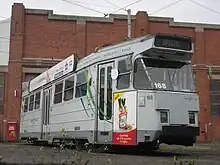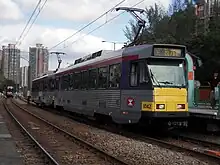 | |
| Industry | Engineering |
|---|---|
| Founded | 1921 |
| Defunct | 1990 |
| Fate | Acquired by ABB Transportation |
| Headquarters | |
Number of locations | Dandenong Rocklea Bassendean |
| Products | Railway rolling stock |
| Parent | Australian National Industries |
Commonwealth Engineering (often shortened to Com-Eng, later Comeng [/ˈkɒmɛndʒ/ KOM-enj]) was an Australian engineering company that designed and built railway locomotives, rolling stock and trams.
History
Smith and Waddington, the predecessor to Commonwealth Engineering, was founded in 1921, in the Sydney suburb of Camperdown, as a body builder for custom motor cars. It went bankrupt in the Depression, and was reformed as Waddingtons Body Works and the main factory was moved to Granville, after a fire in the main workshop. The Government of Australia took control of the company during World War II as the company was in serious financial difficulties but had many government orders in its books. The government purchased a controlling stake in the company in 1946 and changed the name to Commonwealth Engineering.[1]
In 1949 a factory was established in Rocklea, Queensland. This was followed in 1952 by a plant in Bassendean, Western Australia and in 1954 by another in Dandenong, Victoria. In June 1957, the government sold its shares. In November 1982 Comeng was taken over by Australian National Industries.
The Granville factory closed in 1989 and has been demolished. The site, which was situated between the Great Western Highway and Main Western railway line west of Duck River, has been replaced with new developments including high-rise housing and light industries.
In 1990, the Dandenong plant was sold to ABB (later Bombardier Transportation, now Alstom), while the Bassendean facility was sold to A Goninan & Co.
John Dunn has written a history of Comeng:
Buses
Australian Capital Territory
- 60 Canberra Bus Service AEC Reliance 470s
- 30 Canberra Bus Service AEC Swift 505s
New South Wales
Victoria
- 50 AEC Regal IIIs
Western Australia
Leyland OPSU1/1s
Diesel locomotives
XP2009 at Tallarook in November 2011
New South Wales
- 8 BHP Port Kembla D1 class diesel locomotives
- 6 442 class diesel locomotives
- 10 70 class diesel hydraulic locomotives
- 50 80 class diesel electric locomotives
- 15 XPT power cars
Queensland
- 1 Mount Isa Mines 302 class diesel-hydraulic locomotive
- 1 Mount Isa Mines 305 class diesel-hydraulic locomotive
- 7 DL class locomotives for Innisfail Tramway operations
Western Australia
.JPG.webp)
- 1 MRWA E class locomotive
- 10 WAGR B class locomotives
- 11 Westrail N class diesel locomotives
- Alco 636 M636 diesel locomotives for Hamersley Iron
- 21 Alco 636 diesel locomotives for Mount Newman Mining
- 12 Alco 636 diesel locomotives for Robe River Mining
Electric locomotives
New South Wales
Queensland
- 18 3100 class electric locomotive
- 68 3200 class electric locomotive
Diesel multiple units
New South Wales
Queensland
South Australia
Western Australia
Tasmania
- 6 Tasmanian Government Railways DP class railcars
India
- Diesel railcars for Indian Railways[7]
Electric multiple units
New South Wales
- 80 Sputnik Sydney suburban carriages
- 80 U set Intercity carriages
- 359 S set Sydney suburban carriages
- 246 V set Intercity carriages
- 11 Skitube Alpine Railway electric carriages
Victoria

Carriages

Commonwealth Railways
Long Island Rail Road
- 10 C1 bilevel cars (design only; built by Tokyu Car Corporation)
New South Wales
Queensland
Trams and light rail


New South Wales
Victoria
Hong Kong
- 70 MTR Phase I Light Rail Vehicles 1988
References
- 1 2 Dunn, John (2006). Comeng: A history of Commonwealth Engineering: Volume 1: 1921-1955. Rosenberg Publishing. ISBN 1877058424.
- ↑ Dunn, John (2008). Comeng: A history of Commonwealth Engineering: Volume 2: 1955-1966. Rosenberg Publishing. ISBN 978-1877058738.
- ↑ Dunn, John (2010). Comeng: A history of Commonwealth Engineering: Volume 3: 1967-1977. Rosenberg Publishing. ISBN 9781877058905.
- ↑ Dunn, John (2013). Comeng: A history of Commonwealth Engineering: Volume 4: 1977-1985. Rosenberg Publishing. ISBN 9781922013514.
- ↑ Dunn, John (2013). Comeng: A History of Commonwealth Engineering. Vol. 5: 1985–1990. Kenthurst, New South Wales: Rosenberg Publishing. ISBN 978-1-922013-52-1.
- ↑ "John Dunn Obituary". The Sydney Morning Herald. 5 January 2013. Retrieved 10 January 2013.
- ↑ The Indian Railcar Contract Adam, Eric Australian Railway Historical Society Bulletin, December 1989 pp285-291
External links
![]() Media related to Commonwealth Engineering at Wikimedia Commons
Media related to Commonwealth Engineering at Wikimedia Commons
_bus_1877_(GSU_378)_1947_Albion_Venturer_CX19_Comeng%252C_2009_Glasgow_Vintage_Vehicle_Trust_open_day.jpg.webp)



